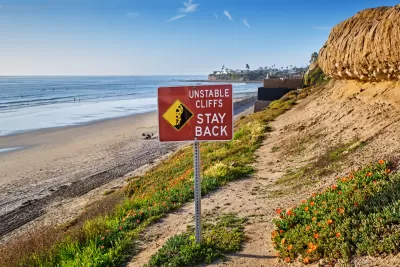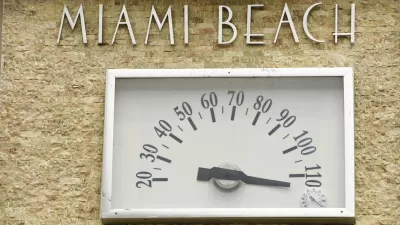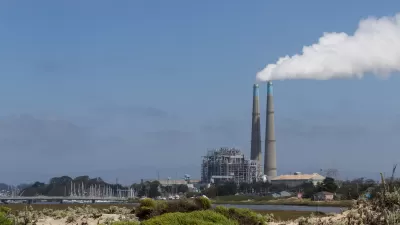The Biden Administration announced the second massive investment of federal funds for coastal resilience on June 6. The Inflation Reduction Act allocated $3.3 billion to NOAA. In March, the Infrastructure Investment & Jobs Act added $562 billion.

The National Oceanic and Atmospheric Administration (NOAA), a bureau within the U.S. Department of Commerce, is a major beneficiary of the Biden Administration's two signature climate, energy, and infrastructure laws that can easily be confused with each other.
On June 6, the “Commerce Department announced it will put $2.6 billion toward coastal climate resilience in funds from the Inflation Reduction Act (IRA),” reported Zack Budryk, who covers energy and environmental issues for The Hill.
The funds are part of $3.3 billion allocated to NOAA by the IRA. The Biden administration previously allocated about $562 million in coastal climate resilience in April through the Bipartisan Infrastructure Law [aka Infrastructure Investment and Jobs Act or IIJA].
Related in Planetizen:
- 'Inflation Reduction Act' a Mixed Bag for Climate Action, Planning Innovation, August 1, 2022
- Key Details of the $1.2 Trillion Federal Infrastructure Bill, November 15, 2021
“Under President Biden’s leadership, we are making the most significant direct investment in climate resilience in the nation’s history,” said U.S. Secretary of Commerce Gina Raimondo in the NOAA press release.
The historic $2.6 billion investment in climate resilience and coastal communities will help ensure communities, especially Tribes and vulnerable populations, have the resources and support needed to prepare, adapt and build resilience to weather and climate events as well as strengthen workforce development, marine resources, nature-based solutions, conservation, regional partnerships and Tribal priorities.
Biden joins the action
The president himself took the opportunity during a three-day trip to California to announce NOAA's newest program, the Climate Resilience Regional Challenge made possible by the aforementioned IRA investment.
“Standing in front of salt marshes at the edge of the San Francisco Bay on Monday, President Biden announced $600 million in funding for coastal communities building projects to protect against the impacts of climate change, as well as $2.3 billion to bolster electric grid resilience,” reported Danielle Echeverria for the San Francisco Chronicle on June 19.
Joined by Gov. Gavin Newsom, Peninsula congresswoman Anna Eshoo, Santa Clara County and Palo Alto elected officials and local activists at the Lucy Evans Baylands Nature Interpretive Center in Palo Alto, Biden said that the funding was part of his administration’s focus on “aggressive climate action” amid the devastating impacts of climate change, including wildfires, drought and floods in California.
“The Challenge is the first and largest funding opportunity released under the $2.6 billion Inflation Reduction Act climate resilience framework that the Department unveiled earlier this month,” according to NOAA's announcement on June 20.
The power grid resilience funding from the Infrastructure Investment and Jobs Act (IIJA) was announced by the U.S. Department of Energy last July.
Distinguishing the IRA and IIJA
What's notable about the climate resilience investments is that they focus largely on climate adaptation rather than mitigation of emissions. It was that focus that helped the IIJA to receive the support of 19 GOP senators on August 10, 2021, led in part by Sen. Bill Cassidy of Louisiana, enabling it to pass a Senate filibuster.
The IRA, on the other hand, bypassed the filibuster as a reconciliation bill on Aug. 7, 2022, receiving no GOP votes in either house. It remains a GOP target for repeal.
FULL STORY: Biden administration announces $2.6 billion toward coastal climate resilience

Trump Administration Could Effectively End Housing Voucher Program
Federal officials are eyeing major cuts to the Section 8 program that helps millions of low-income households pay rent.

Planetizen Federal Action Tracker
A weekly monitor of how Trump’s orders and actions are impacting planners and planning in America.

Canada vs. Kamala: Whose Liberal Housing Platform Comes Out on Top?
As Canada votes for a new Prime Minister, what can America learn from the leading liberal candidate of its neighbor to the north?

Washington State’s Parking Reform Law Could Unlock ‘Countless’ Acres for New Housing
A law that limits how much parking cities can require for residential amd commercial developments could lead to a construction boom.

Wildlife Rebounds After the Eaton Fire
Following the devastation of the Eaton Fire, the return of wildlife and the regrowth of native plants are offering powerful signs of resilience and renewal.

LA to Replace Inglewood Light Rail Project With Bus Shuttles
LA Metro says the change is in response to community engagement and that the new design will be ready before the 2028 Olympic Games.
Urban Design for Planners 1: Software Tools
This six-course series explores essential urban design concepts using open source software and equips planners with the tools they need to participate fully in the urban design process.
Planning for Universal Design
Learn the tools for implementing Universal Design in planning regulations.
Central Transportation Planning Staff/Boston Region MPO
Heyer Gruel & Associates PA
Institute for Housing and Urban Development Studies (IHS)
City of Grandview
Harvard GSD Executive Education
Regional Transportation Commission of Southern Nevada
Toledo-Lucas County Plan Commissions





























